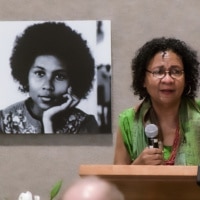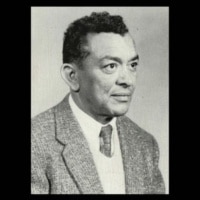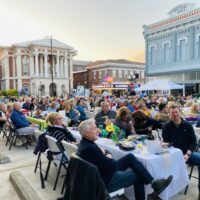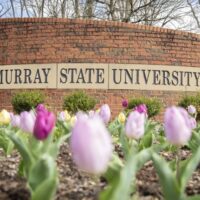One of the oldest and most enduring myths about the Appalachian Mountains is that they are now and always have been overwhelmingly populated by white Scots-Irish. Dr. William H. Turner has written a new book, “The Harlan Renaissance: Stories of Black Life in Appalachian Coal Towns,” that kills that myth about whiteness and, for good measure, buries several more myths as well. It is fair to say this is a very scholarly assault on J.D. Vance’s “Hillbilly Elegy” and his insistence that mountaineers created and deserve their poverty.
In this book — part memoir, part history, and much sociology — Turner paints intimate portraits of the Black coal miners and their families who migrated from central Alabama to the coalfields of Kentucky, Virginia, and West Virginia around the turn of the last century. This is — without question — the most detailed history of those coal camps that describes how Black people built sustaining communities in the midst of racism and discrimination and still produced so many ambitious, talented, and accomplished sons and daughters in separate and unequal schools.
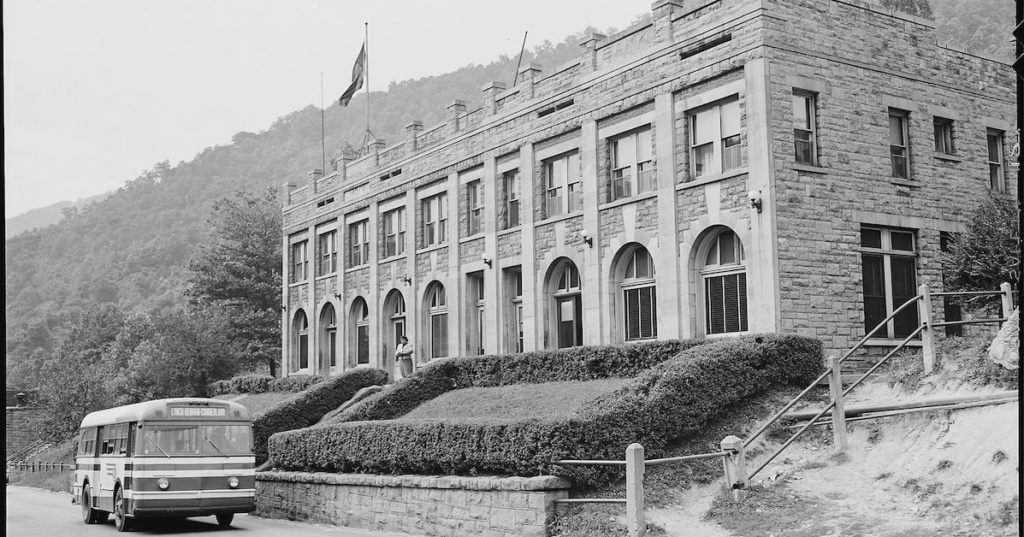
Turner is the son and grandson of miners from the coal towns of Virginia and Kentucky. He grew up in Lynch, Kentucky, in the famous “Bloody Harlan County.” He excels in writing sociology because he holds a Ph.D. in that subject from Notre Dame University. He writes exceedingly well because he is an accomplished journalist whose work has appeared in numerous outlets (including the Daily Yonder). And he knows all the coal towns across Appalachia because he has spent a career visiting them and interviewing hundreds of mining families.
Turner’s encouragement for writing this book came from his close friend Alex Haley (1921-1992), the author of the Pulitzer-winning book “Roots” that was turned into a miniseries by ABC that attracted 130 million viewers in 1977 and launched a nation on a genealogical pastime for Black and White people. Haley became fascinated with Appalachia, retired to east Tennessee, and helped to popularize the Museum of Appalachia, a Smithsonian Affiliate at Norris, Tennessee, created by John Rice Irwin (1930-), also a friend of Turner.
To give readers an idea of how neglected the subject of Black Appalachians has been historically, Turner quotes this paragraph from a 1971 article in “The Journal of the Committee of Southern Churchmen,” the publication of a Nashville group heavily involved in the civil rights movement:
One group of Appalachians who are consistently overlooked and underserved by the institutions of the region is the Blacks. While the percentage of Blacks in the region is low, about eight percent, they make up the entire population of many isolated small hollows and ghost coal towns abandoned by the corporations and welfare and poverty agencies. Because the backbreaking jobs that brought Black imports into the region are gone and because of the discrimination and competition with mostly poor white people for jobs and welfare funds, their existence is a poor one indeed. As yet, no agency or journalist has documented the presence and needs of these people, let alone described the culture of a minority group in the midst of another cultural minority.
Thanks, Bill. I wrote that paragraph. And thanks to this book, we now know a great deal about “the culture of a minority group in the midst of another cultural minority.” The book accomplishes much more, however, by describing how Black coal mining families built and maintained a supportive community structure in which people thrived despite the odds. There are important lessons here for a nation that worries we have lost that sense of community to corrosive individualism that imperils democracy and cherishes self-seeking above common values.
The town of Lynch was built beginning in 1917 by U.S. Steel to be a model coal town producing high-quality coking coal from a mine under Black Mountain, Kentucky’s highest, for its steel mills in Gary, Indiana. By the 1940’s, according to Turner, who was born in 1946, the town had a population of nearly 12,000, one-third of them Blacks from mainly Alabama and a total of 38 nationalities that had been recruited from arrivals at Ellis Island for their specific skills in matters like stone masonry and carpentry. Again, contrary to J.D. Vance, Lynch and other coal towns like it were as cosmopolitan as New York City.
The homes for the White families were larger than the basic four rooms given to Black families. Black miners were paid the same amount of scrip — company currency that could only be used at the company store — as Whites miners, but they began and ended their mine shifts in separate outfitting rooms from the Whites. The company provided the Lynch Colored School for the Black children — there were a total of 10 in Turner’s family.
That school and its highly educated Black teachers and principals, along with the Black churches, were a key building block of the community. There was not a lot of race mixing outside the mines, but Lynch was far more hospitable than the nearby “sundown town” of Corbin where Black residents were threatened after dark, and which literally railroaded 250 of its Black citizens out of town in 1919. Corbin was where the Lynch coal was washed in its final preparation and the city where Colonel Harlan Sanders perfected Kentucky Fried Chicken.
Turner very eloquently describes how the Black residents viewed their lives in Lynch:
Our connections to this land attached us to it like chocolate-colored railroad crossties atop crushed white gravel. We were spiked down and anchored in place there, able to carry heavy loads and perform a balancing act on life’s narrow steel rails, our arms outstretched the way an acrobat holds a stabilizing pole while on a high wire, looking up and moving forward, one step at a time, gingerly. Even though I never traveled far beyond Lynch during my first twenty years, I read enough magazines like Jet, Ebony, Look, Life, Reader’s Digest, National Geographic, and the Saturday Evening Post to appreciate its relatively well-designed and orderly surroundings and the durability, toughness, and graciousness of the people. That said, I never went around humming the state song, “My Old Kentucky Home,” as though the place was that charming, picturesque, and serene. We seemed to know, intuitively, that our Appalachian coal-town hollow was a temporary stopover to some other promised land.
Anyone who has attended a one-room school well anchored in its community, sat in a country store where the old men chewed and spit tobacco at the pot-bellied stove, or otherwise hung around the small-town spots where elders gathered to pass along “culture,” will appreciate Turner’s vivid and colorful description of the retired Black miners who gathered under a giant oak to wile away the time. That spot had what he called an “insider’s” title. Here’s the description of it from Turner’s friend Buttermilk:
Damn near everything of what I learned about life, I learned it under the Dead Dick Tree. Big George Gnat Washington taught me how to move from one spot to another without moving your car so your old lady wouldn’t know where you were at. He would get dropped off and walk to his spots. Seaboat and Mr. Jack could teach you how to squirrel hunt right there under the tree. John Thomas taught me how to fish — right under the tree. They were the kind of men who, when they were making a point about life and how to live, would tap you gently on the shoulder. Sam Cole, the local loan shark, would go back and forth home and bring back a different type of pistol each time. I have a license to carry a gun right now because I learned at the Dead Dick Tree: “Better the po’leece catch you wid dis gun den some crazy peckerwoods catch you without it!” But I don’t have to worry if a policeman sees my weapon when I choose to carry it openly — Texas is Kentucky on steroids when it comes to crazy White boys!
Turner has a lengthy and detailed history of what school integration did to undermine the community’s dependence upon the Lynch Colored School as one pillar of the community. He’s not saying integration was a bad idea; only that integration was badly done, at the expense of Black teachers and principals and the larger Black community. The photos of famous Black leaders disappeared from the hallways. Just as Black coal miners were the first to be let go when the mines began to decline in the 1950’s, so were those Black teachers and coaches who had turned out a generation of Black students who excelled and often exceeded the White students in academia and professional life. Those basketball coaches turned out three students who played for the famous Harlem Globetrotters.
The Lynch mines, of course, have closed and miners are a measly 1 or 2% of the workforce in the coalfields, with that percentage declining by the month. A large percentage of the Black residents have moved on but still gather annually at a large reunion in various cities as distant as Detroit and Atlanta under the umbrella of the East Kentucky Social Club. The White residents who have left the region don’t do that.
The book raises the question of why the opiate addiction plague that has hit the region’s White population has mostly skipped the remaining Blacks residents. It must have something to do with those strong, nurturing communities the Black families built in those coal camps. After all, hope is the best antidote to those so-called “diseases of despair.”
Bill Turner is a bow-tie-wearing academic and great fisherman who has worked as a professor at many universities, some historically Black and some not. He is on a mission, reflected in this book, to help coal camp residents and students at Yale — he lectures at both–understand what was built and what was lost in those coal camps during the “Harlan Renaissance.” He is comfortable and engaging in both of those venues. What is striking is his optimism and hope that there is another renaissance in the making in the mountains. He is especially enthused to note that after the death of George Floyd there were scores of White and Black mountain youth who turned out to protest all over the coalfields. Yes, even in the town of Corbin, the one that shipped all its Black citizens out of town in railroad cars a century ago. “We are all Appalachians,” he proclaims.
Here’s his conclusion of hope for Appalachia and the country:
Those who kept their hopes alive by working the mines of central Appalachia breathed a lot of “bad air,” but they survived — and many thrived — by drawing in courage and faith and exhaling hope to the future generations. As a direct result of growing up in an industrial town, one where planning, hard work, and ingenuity transformed a wilderness into a relatively bountiful human beehive that sustained life — and hope and faith — for legions of otherwise rootless Black people, I developed an industrial-strength sense of optimism and positivity. Even the trees that were felled a century ago to make the homes we lived in have been replaced, and life has been renewed. Similarly, I believe, and hope, that yet another Harlan Renaissance — another recovery, an additional regeneration, and an extra special revival — will arrive in the once vibrant coal towns of central Appalachia. This is America, and despite its warts and scars, it is still ground zero for people of hope and faith who possess the determination, the perseverance, and the pluck necessary to survive the down cycles and the changes and to flourish and succeed into the great beyond. Central Appalachia is still home to many Black people, natives to the area, and they, and their heirs, are not going anywhere. After all, where is there to go? Appalachia’s fortunes are America’s riches and the other way around. Appalachia is mainstreamed, finally.
Bill Turner’s “Harlan Renaissance” should be made into a movie. It would be far better reviewed than J.D. Vance’s “Hillbilly Elegy” movie.
James Branscome is a retired managing director of Standard & Poor’s and a former journalist whose articles have appeared in the Washington Post, York Times, Business Week, and Mountain Eagle of Whitesburg, Kentucky. He was a staff member in 1969-71 at the Appalachian Regional Commission, a lobbyist for Save Our Kentucky in Frankfort, and a staff member of the Appalachian Project at the Highlander Research and Education Center in New Market, Tennessee. He was born in Hillsville, Virginia, and is a graduate of Berea College in Kentucky.
